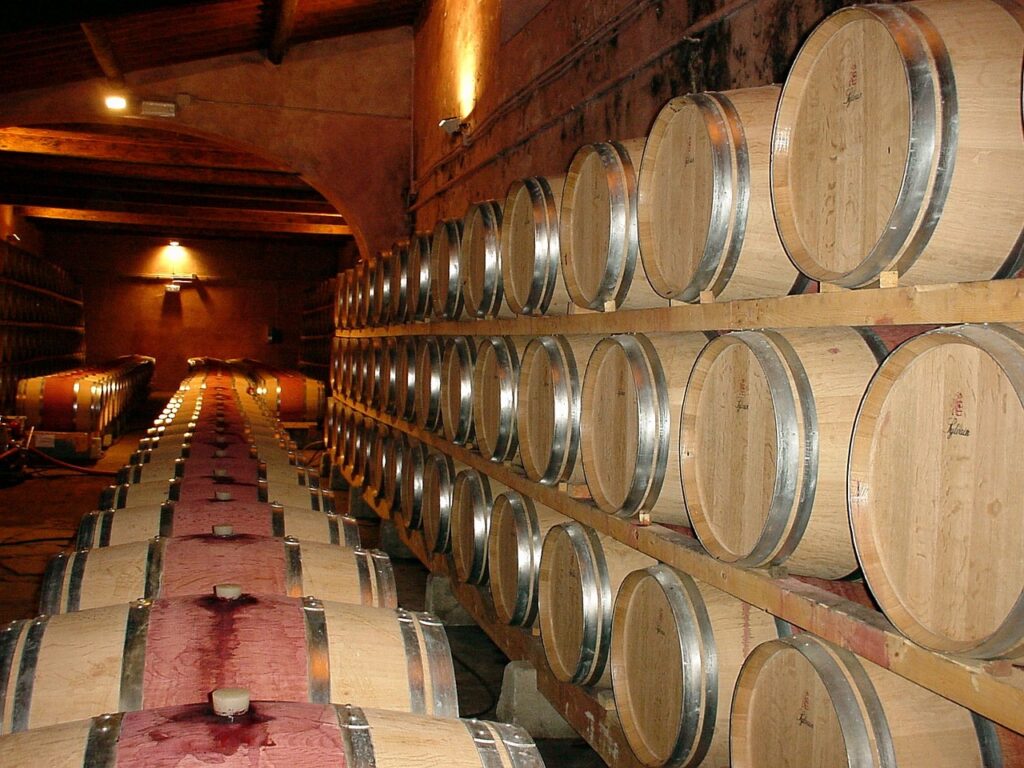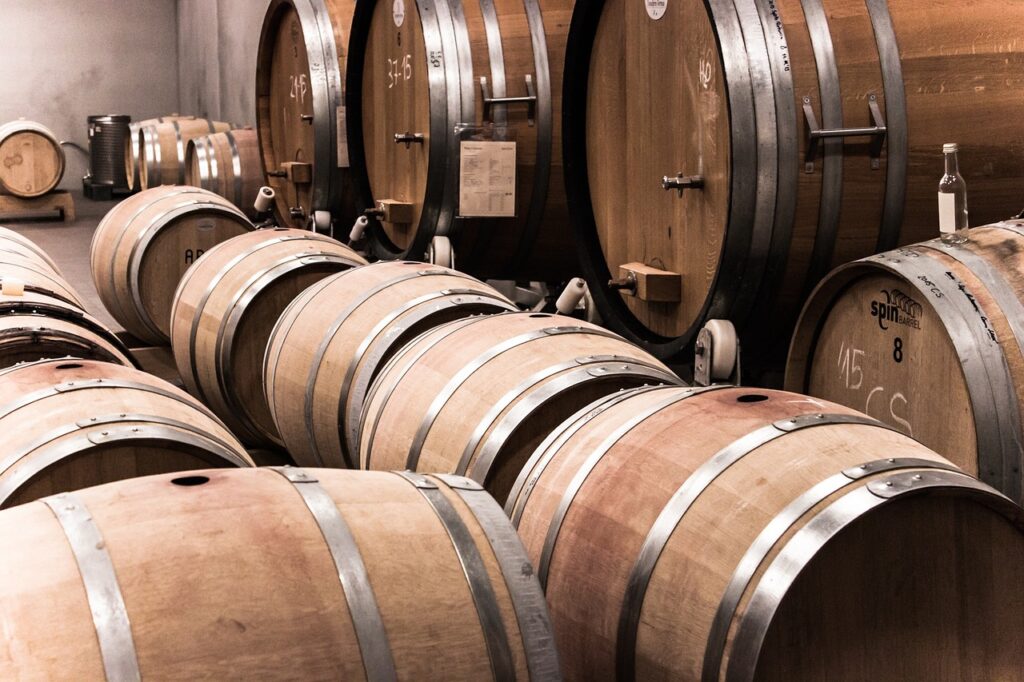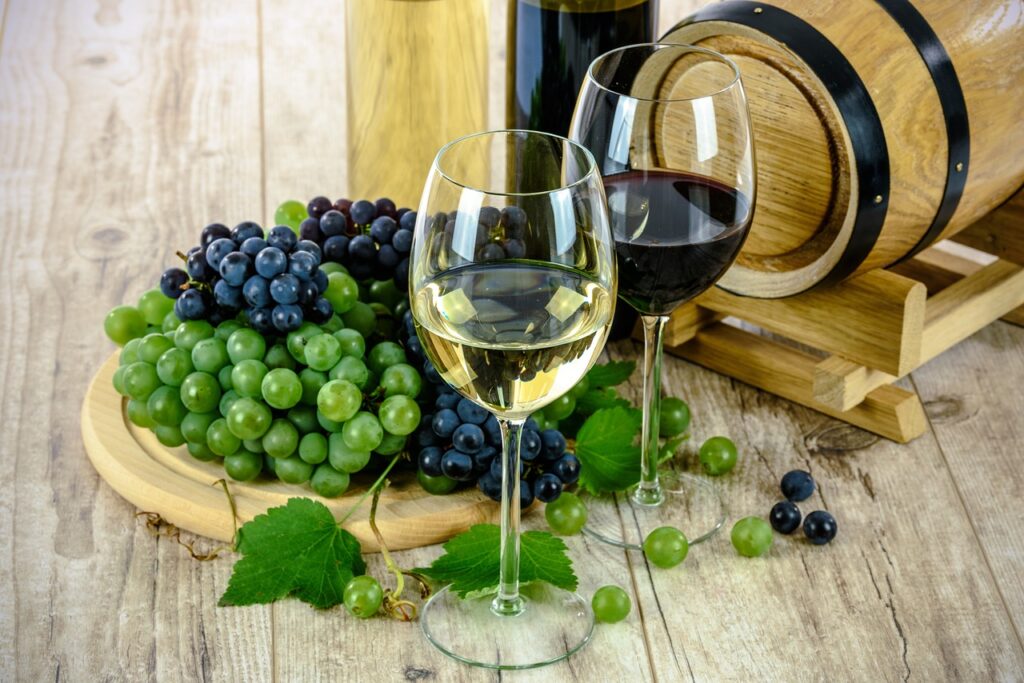Oak barrels and wine have been in close union for a long time. They are inextricably linked: the use of an oak barrel helps to influence the organoleptic of wine, making it more saturated, balanced, and enjoyable. Aging in oak containers is the finishing touch in the production technology of noble drinks. Barrels are used for aging, convenient transportation and storage of wine. Let’s consider why oak has gained popularity and how it affects the taste of drinks.
Why was wine stored in barrels?

Wine is considered one of the oldest drinks. Winemaking was practiced even before our era, but in those days, noble drinks were not aged in oak barrels but were stored in clay amphorae.
Pay attention! In Mesopotamia, barrels made of palm wood were used instead of amphorae. However, this is only an exception to the rule.
The soldiers of the Roman Empire carried weapons and food with them during their campaigns. Wine replaced water since its use was much safer. It successfully quenched thirst, removed toxins from the body, gave strength to soldiers, destroyed microbes, and added calories to the soldiers’ diet. However, it wasn’t easy to transport heavy clay amphorae. It was impossible to replace them with palm barrels since the wood variety needed complex processing, and because of this, the price per container increased.
In one of the campaigns, the Romans learned about the Gauls, who made oak barrels for storing beer. The oak was perfectly amenable to processing: the boards bent easily, and firing was unnecessary.
Types of barrels for aging and storage
Like the noble drink itself, classic oak barrels for wine are made in France. There are the following varieties:
- Fudr (made in Alsace) – 30,000 to 300,000 liters;
- Tinie volume from 1000 to 50,000 litres;
- Caratello – 1,000 litres; there is also a smaller volume variety, from 25 to 200 litres;
- Pipa (used for cognac and port) – from 420 to 630 litres;
- Botti (have a round or cylindrical shape) – from 400 l;
- Pis or tonne (used in Burgundy) – 350 l;
- Barrick (from the French city of Cognac) – 350 l;
- Barrick (from Porto) – 250-260 l;
- Barrick (from Bordeaux) – 225 litres;
- Pis (originally from Champagne) – 182 litres.
Pay attention! Oak barrels are also made in Germany. For example, for the storage of wines made in the German region of the Rhine, a 1200-liter Stück is used. For the aging and storage of Moselle drinks, 1000-liter Fuder (Fuder) and 500-liter Halbstück (Halbstück) are used.
Australia and New Zealand also have an analogue of the French Barrique Barrique from Bordeaux. There, the capacity calls
What materials are they made of?

With the first wooden barrels for wine, oak, acacia, chestnut, maple, and palm were used for production. However, after many experiments, we settled on oak wood since it bends most easily and needs minimal firing. Due to these properties, oak barrels are made as quickly as possible. In addition, the texture of oak is characterized by good water resistance, and many oak trees grow in Europe.
Over time, the winemakers noticed that when stored in oak barrels, the wine is saturated with new pleasant shades, fully reveals the taste and becomes stronger. Trees that are more than 100 years old are used for production.
Currently, oak barrels are made from the following oak varieties:
- French. This material is the most popular, as it contains many tannins. Among this type of trees, several varieties are used: limousin (for aging cognac and fortified wines). From the forests of Tronce (gives the drinks rich oak aromas) Vosges (saturates the wines with tannin and makes them more robust).
- Eastern European. Barrels made of this material are used for maturing and storing white wines. This variety helps maintain a balance between tannin and aroma.
- American. The containers are very dense and heavy. Such wood contains minimal tannins but enriches drinks with rich vanilla tones. Most often, such barrels are used for aging and storing bourbon.
How are barrels prepared for storing wines?
The production of barrels for storing wine is quite simple: choose a material, divide it into identical decks, dry it, form a barrel, burn it, make a chamfer (for barrels up to 50 litres) and tutor, and then subject it to grinding and galvanizing. After that, the containers are ready for sale, but ready-made wines cannot be poured into them immediately, as the drinks will become excessively strong due to the large amount of tannins.
Barrels for aging and storage of beverages undergo additional processing at the winery. It can be divided into the following stages:
- Soaking. The container is filled with water and closed with a stopper. For a month, the liquid is changed two or three times a week until it becomes transparent and clean. When foreign odours, dust, dirt and various impurities leave the barrel, you can proceed to the next stage.
- Steaming. This procedure makes it possible to disinfect the wood and enhance its aroma. You must put heated stones at the bottom of the container and fill them with 1/3 boiling water. Next, the barrel and the tap for drinks are closed so that steam clubs do not come out. After the vaporization decreases, adding boiling water 2-3 more times is necessary, repeating the procedure. Then, you must wait for the liquid to warm and completely drain it from the barrel. Next, you should wait for the barrel to dry and pour the wine into it.
- Keeping. The room should be dark. You can use incandescent lamps to illuminate it. It is essential to ventilate the room regularly to avoid the appearance of foreign odours. It is also necessary to ensure that there are no drafts. The optimal temperature is +10-14 ° C. Humidity should be about 75-85%.
- Installation. The barrels should not touch each other. The minimum distance between the barrel and the wall should be 50 cm, and between the barrel and the floor, it should be 60 cm.
- Care of barrels. It is essential to store oak containers properly before and after use. For storage, it is necessary to allocate a clean room with good ventilation to avoid foreign odours and drafts. Covering the barrel with a bag or an ordinary cloth to protect it from dust and dirt is best. During storage, it is essential to put containers not on the ground but on unique stands or racks.
You should also check the hoops. If they sit too loosely, you can strengthen the fixation with a pad and a hammer. After that, the barrels are entirely ready for use. They will serve for many years, filling drinks with new flavours.
How does wine behave in a barrel?
Back in the days of the Roman Empire, people realized that wine became more affluent, fragrant and potent when stored in oak barrels. At the same time, the longer the process lasts, the more exciting and multifaceted the taste of the drink becomes.
An oak barrel performs several tasks at once:
- Aeration. Oak, despite its dense texture, has tiny pores. For this reason, a small amount of air enters the container, which can lead to oxidation of the wine. As a result, the acidity and tannin of the drink decrease, and the aroma becomes softer, fruity, and complex. During aeration, white drinks darken, and red ones change their shade to brick.
- Saturation with aromas. The wine absorbs oak extracts. Smoky shades of vanilla, chocolate, cloves, cinnamon and tobacco appear in the drink.
- Concentration of taste. Wines lose about 2-4.5% of the total volume annually in the barrel. Due to evaporation, the drink becomes more saturated, multifaceted and complex. However, this process must be carefully monitored since the place of the evaporated liquid is occupied by air. This can lead to excessively rapid oxidation, as a result of which the wine may spoil.
Also, the drink becomes softer and is drunk much easier. In any wine, even table wine, which is not exceptionally high-quality, unique notes of butter, cinnamon, vanilla, and woody shades appear after aging.
Disadvantages of storing wine in barrels
The storage of wine in barrels also has disadvantages. For example, with excessive wood firing or prolonged aging in oak barrels, the wine can become “overdubbed.” Tannic aromas will interrupt the other shades of the bouquet, which is why the drink may seem tart and bitter.
It’s important to know! Wines from some grape varieties, mainly white, are not subject to long-term aging in oak barrels. When stored in oak barrels, the noble drink may lose its lightness, aroma and freshness.
In addition, aged wines or those subject to barrel storage are more expensive.
What wines are stored in barrels?
Not all wine varieties are subject to aging and storage in barrels. This is done only with red wines, but there are some features here:
- Australian Shiraz, Grenache, Malbec and Chilean Merlot are aged in new wooden vats;
- French Beaujolais are placed not in an oak barrel but in steel containers;
- light and fruity Pinot Noir and Gamay are stored in oak barrels previously used for aging other drinks.
White wines are often aged in stainless steel containers, as they do not have tannins and may lose their authenticity. Drinks made from Chenin Blanc, Chardonnay and Riesling grapes are placed in oak barrels for a short period.
Storage conditions of wine in barrels
It is necessary to store wine in oak barrels in a dark room where sunlight does not fall. Maintaining a specific temperature regime is also essential: about +10-14 °C.
Humidity values should vary from 75% to 85%. Also, the room should have no drafts, temperature differences, or foreign odours. Under improper storage conditions, wine can acquire an unpleasant taste and aroma.
Table and white wines should be placed in old barrels and red – in new ones. The service life of the containers varies from 5 to 7 years. After this period, they stop giving tannins and flavours to the drink, do not improve its taste and become neutral. Then, they are used to store alcohol of a higher strength.
During storage, barrels of wine are placed in stacks or racks. Containers should not be placed on the ground; pallets can be used for storage.

